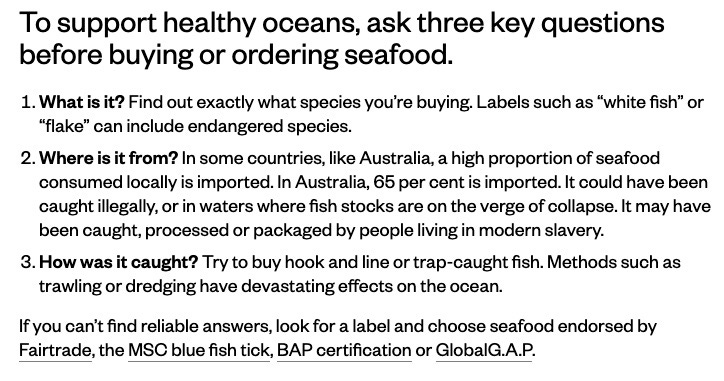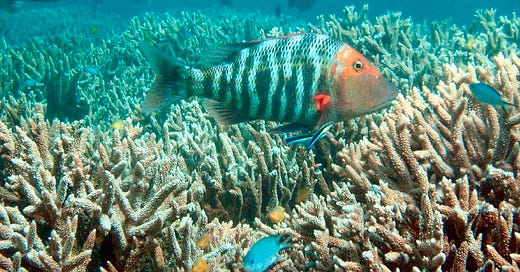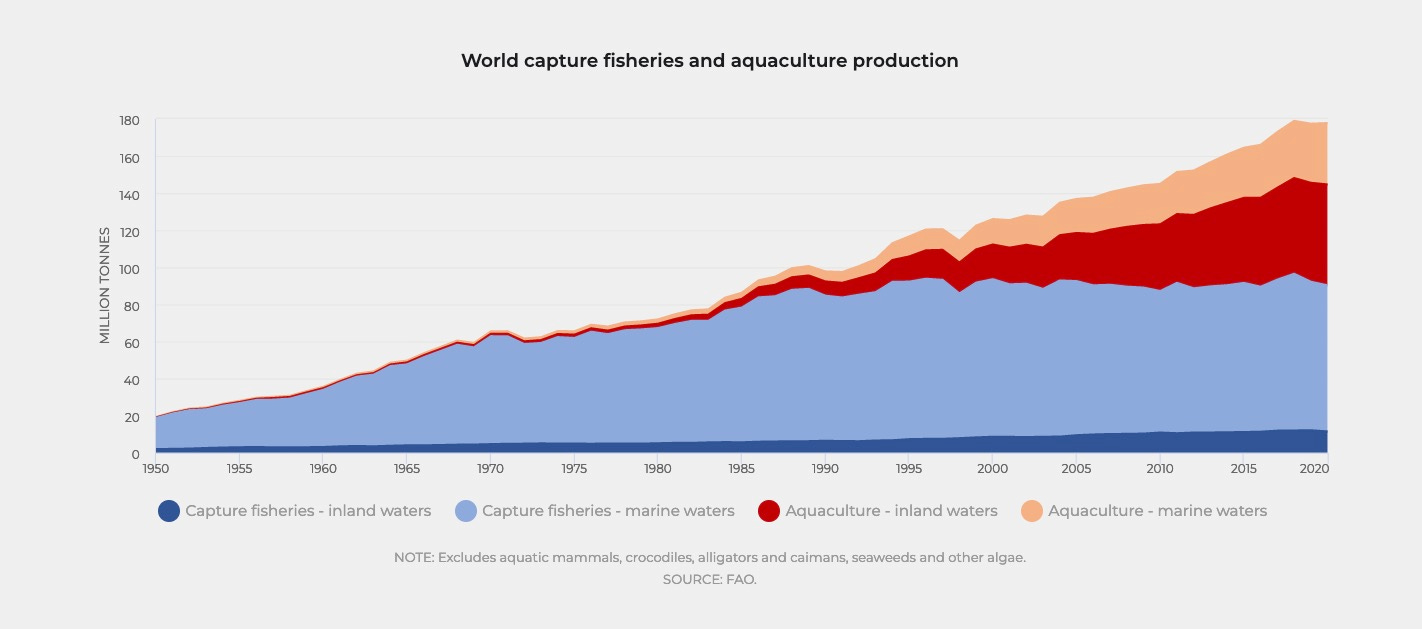Have We Reached Peak Fish?
Seafood is a vital source of protein for more than 3.3 billion people.
The UN Food and Agriculture Organization (FAO) projects the need for a 15% increase in global fish consumption by 2030.
The growth of fisheries and aquaculture is vital in our efforts to end global hunger and malnutrition. — FAO Director General, QU Dongyu
There’s one big problem: The growth rate of the global wild-fish catch peaked in 1963 and plateaued in the 1990s. It has been in slow decline the last few years. When it comes to the wild-fish catch, we are likely past “peak fish”.
Need-to-Know: Virtually all of the oceans are overfished or at their maximum capacity.
An assessment of 1,439 wild-fish populations found that 10% are on the brink of collapse. Another 45% are overfished and there isn’t enough information about the rest to know if the current fishing levels are sustainable, according to 2021 Global Fishing Index.
Over the past 50 years, the world has witnessed a massive decline in the health of its fisheries. Quite simply, we are removing fish from the ocean at a far greater rate than they can naturally replenish. — Global Fishing Index
The oceans are in a serious health crisis. Here’s four reasons why:
1. Overfishing, and particularly bottom trawling that destroys corals and other habitat.
Marine pollution, especially hundreds of millions of tons of plastics.
Climate change is heating up water temperatures.
Emissions of CO2 have made the oceans 26% more acidic.
(A previous NtK issue looked at what climate heating was doing to the oceans or Ocean as I called it in Beware! The long-buried Colossal-Heat-Monster Kraken is Coming!)
Ok, so for better or worse, aquaculture is the solution to the looming seafood shortage right?
Turns out, nope.
Need-to-Know: Peak Aquaculture is right around the corner
Aquaculture’s growth rate has been in decline since 1996. While the industry did experience rapid growth decades ago, its five-year moving-average-annual-growth rate peaked at 14.1% in 1996 to around 2%, according to a new study in Frontiers in Marine Science.
Here’s a few reasons why “peak aquaculture” is around the corner:
Constraints on good places to site fish farms.
Lack of high-quality water availability.
Cost and availability of food for the farmed species.
Disease and pest pressure.
Impacts of climate change and weather variability.
Increasing opposition to ocean-based fish farms.
On Canada’s west coast years of protests by the local fishing community, indigenous groups and environmentalists has led a phase out of more than 100 salmon fish-farms by 2025.
Need-to-Know: Every country has agreed to protect 30% of their piece of the oceans.
Properly managed, the oceans could provide far more fish than today, according to many marine scientists. In fact, global fisheries catches could generate 16 million more tons annually over and above the current production levels studies have found. That would require sound management.
Recent agreements and proposals to better manage and protect oceans include:
30% of oceans are now to be protected under the recent Convention on Biological Diversity (COP 15) decision.
The World Trade Organization has agreed to ban harmful fisheries subsidies. (Fisheries subsidies are estimated to be $15.4 billion per year, primarily from China, Japan and the EU.)
Governance of the high seas, beyond countries’ economic zones (EEZs), is being strengthened under the UN Law of the Sea.
Negotiations are underway for a binding global treaty to end plastic pollution.
I’d like to highlight the importance of marine protected areas (MPAs).
MPAs are no-fish or limited fishing zones that become a refuge for fish and protection for the overall marine ecosystem. It is particularly important to protect larger, older fish because they can produce hundreds or thousands more offspring over their lifetime that go on to disperse into unprotected waters. (I wrote one the first articles about this back in 2005 for New Scientist.)

Need-to-Know: Improve ocean health and there will be fish for all.
Study after study shows that a protected ecosystem becomes healthier and fish numbers soar. For example, the biomass (amount of fish) in fully protected MPAs may be 670% greater than in adjacent unprotected areas. Eventually the fish in an MPA spill-over into other areas where they can be caught.
Protecting 30% could go long way to returning the Ocean to its former health and abundance. That would be a very good thing for all of us.
We’ve got to rebuild and take good care of our wild fish, and then when we do sustainable aquaculture, together, hopefully we’ll be able to meet our demand for fish.
— Rashid Sumaila, a fisheries economist at Canada’s Institute for the Oceans and Fisheries.
Until next time, be safe.
Stephen
Welcome to Need to Know: Science & Insight, my personal newsletter that looks at what we Need-to-Know at this time of pandemic, climate emergency and unraveling of nature’s life supports





